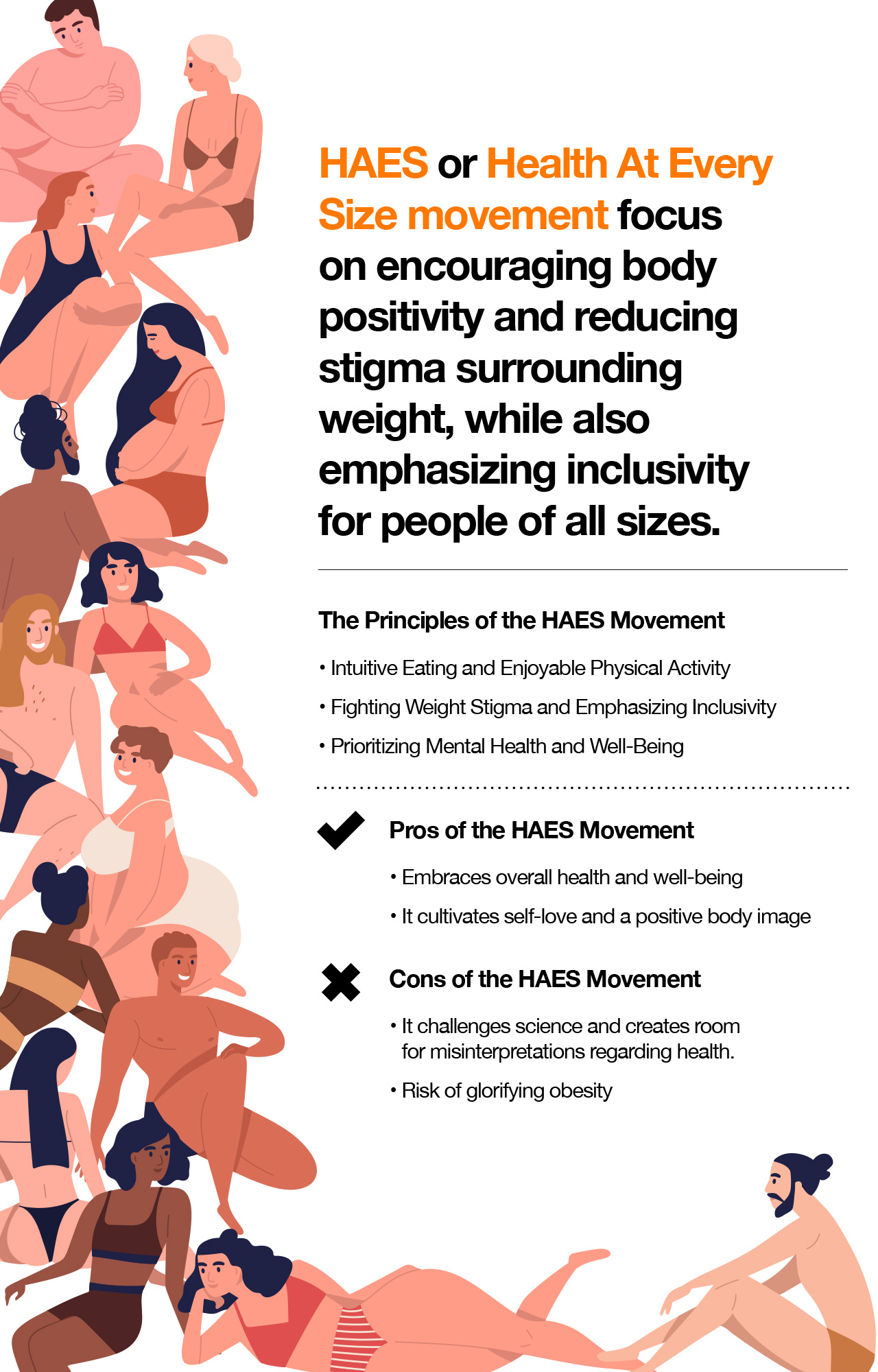Have you heard of the health at every size movement? Also known as the HAES movement, this idea emphasizes the importance of social acceptance of people of all sizes while also asserting the idea that people can be healthy at any size, without pursuing weight loss. Though there are many effective and helpful facets of HAES, the movement also leaves some open questions about health and weight.
Read on to find out more about the health at every size movement.
What Are the Principles of the HAES Movement?
The HAES movement was pioneered by Dr. Lindo Bacon, Ph.D., a researcher in physiology and nutrition. The premise of the movement centers around a paradigm shift towards holistic health, and away from a myopic focus on weight loss. (1)
HAES calls for a public health focus on health instead of only on weight. Overall, the principles of HAES emphasize balance and wellness for both the body and mind. Before we discuss the positive and negative aspects of the HAES movement, let’s first go over its main principles.
Intuitive Eating and Enjoyable Physical Activity
Intuitive eating describes a pattern of eating that is based on listening to your body’s signals. Eating intuitively means you listen to your body and eat when you’re hungry, and stop when you’re full. When you’re eating intuitively, you listen to your body by noting when you’re feeling hungry. While eating, it’s helpful to eat slowly and mindfully, so you can more easily sense satiety. This strategy helps you avoid overeating.
Eating intuitively doesn’t mean eating only what diet culture deems to be “healthy.” Instead, it’s important to practice gentle nutrition instead of dieting. Gentle nutrition calls for a focus on nourishing the body and the mind, instead of a focus on “clean” foods that diet culture tells us we should be eating.
The HAES movement also reframes exercise as something that would be a fun part of the day, instead of something that we use as a “punishment” to change the body. Physical activity should be a part of our daily routine because it’s fun and helps us feel our best, not because we feel like we have to.
Fighting Weight Stigma and Emphasizing Inclusivity
Weight stigma is a social and cultural construct that assigns negative characteristics to individuals with larger bodies. These negative stereotypes often label overweight and obese people, contributing to weight-based discrimination. Stigma based on body weight takes a serious toll on mental health and emotional well-being, as well as physical health. The HAES approach aims to educate the public about the range of factors influencing body size, while also encouraging body positivity and acceptance.
HAES celebrates body diversity and strives to include people of all shapes and sizes under the umbrella of health. HAES aims to encourage the acceptance of all body sizes and body shapes across all areas of society, including schools, communities, and the media. The HAES movement also supports weight inclusivity in healthcare settings and health policies, encouraging providers to take a more weight-neutral approach with patients.
Prioritizing Mental Health and Well-Being
The HAES approach shifts focus from weight control and avoiding weight gain to overall health and well-being. Experiences of stigma and discrimination negatively impact an individual’s mental health, which may in turn have a negative impact on physical health outcomes. People of all sizes should feel accepted and included in society and culture. Feeling accepted helps foster a healthier mindset and improved self-esteem.
Diet culture often pushes restrictive eating habits and extreme diet plans to achieve quick weight loss goals. The media and society bombard us with messages about how being skinny is better, and having a larger body is demonized. The result is an obsession with quick weight loss through undereating, leading to binge eating and weight cycling, as well as an uptick in eating disorders.
The HAES movement rejects conventional dieting, which often emphasizes restrictive eating patterns and eliminates large food groups. Instead, HAES encourages a healthy and balanced lifestyle incorporating a variety of foods that support your needs, combined with self-care and physical activity.
Pros of the HAES Movement
The HAES movement embraces overall health and well-being, which is an excellent goal. Being at a healthy weight is not the only defining factor when it comes to health. Instead, it’s important to also take into account both mental health and physical health.
HAES is also important for improving the mental health of people who may be overweight or obese. Cultivating self-love and a positive body image is vital for good mental health. Breaking down stigma and shifting focus towards health can have a positive impact on mental well-being, especially for those who have a history of eating disorders.
Cons of the HAES Movement
Although there are many positive aspects of the HAES movement, there are also serious flaws. The largest problem is that the HAES movement challenges science and creates room for misinterpretations regarding health that may have dire consequences.
While body positivity and body acceptance are extremely important for mental health, there is a key difference between positivity and glorifying obesity. Decades of medical science tell us that obesity seriously increases the risk of many health problems including heart disease, high blood pressure, type 2 diabetes, fatty liver disease, and even certain cancers. Interventions that emphasize weight loss are important for pursuing optimal physical health.
Moreover, research shows us that obesity is a risk factor for experiencing more serious outcomes and complications of COVID-19. (2) Individuals with a higher body mass index (BMI) are more likely to be hospitalized and require a ventilator than individuals with BMIs within the normal range. (2) Obese individuals are also more likely to die from COVID-19. (2)
Key Takeaways
The health at every size movement has positive intentions. The movements focus on encouraging body positivity and reducing stigma surrounding weight, while also emphasizing inclusivity for people of all sizes. While the social justice aspect of this movement is critical for inclusivity and mental health, HAES leaves room for society to accept obesity, despite the fact that obesity is associated with a higher risk of medical conditions. Combining body positivity with maintaining a healthy weight is the most effective strategy for achieving health.

References:
(1) https://nutritionj.biomedcentral.com/articles/10.1186/1475-2891-10-9























